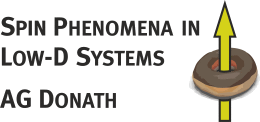Willkommen auf der Homepage der AG Donath


Phys. Rev. B 112, 235408 (2025).
The suitability of transition metal dichalcogenides (TMDCs) for the use as scattering targets in electron spin-polarization detectors is put to a paradigmatic test: a case study of MoS2 is performed. Therefore, the electron reflectivity, the Sherman function, and the figure of merit are measured for the following samples: a single layer of MoS2 on Au(111) and cleaved MoS2 single-crystal surfaces. MoS2 offers promising features for the use in spin-polarization detection: working points with a reversed sign of the Sherman function and a long-term target stability. To overcome the low figure of merit of MoS2 , the closely-related 2D material WS2 with higher spin-orbit interaction is proposed, which may resemble the promising features with higher Sherman function. This study demonstrates the potential suitability of 2D materials such as TMDCs as scattering targets in spin-polarization detectors.
Meas. Sci. Technol. 36, 097002 (2025).
Detection of vacuum-ultraviolet photons in inverse photoemission experiments is usually carried out with gas-filled counting tubes. Iodine/argon gas fillings have been used for Geiger–Müller-type photon detection. The gas filling was later replaced by, for example, acetone to increase stability and the operation was changed to proportional mode. While doing this, the counting tube geometry was not necessarily changed. We carried out a systematic study to understand the photon detection process in acetone-filled counting tubes and to optimize the geometry accordingly. In the range of optimal gas pressures, we found that the photon attenuation length in acetone is of the order of a few millimeters instead of a few centimeters in the iodine/argon case. As a consequence, the position of the cathode wire close to the entrance window thus becomes a critical parameter for optimizing the detection efficiency.
Rev. Sci. Instrum. 96, 033905 (2025).
In angle-resolved photoelectron spectroscopy (ARPES) experiments, the use of polarized light for excitation provides access to the orbital symmetries of the electronic states under investigation. In angle-resolved inverse photoemission (IPE), the equivalent approach is the polarization analysis of the emitted light. So far, this light-polarization analysis has been neglected for intensity reasons due to the much lower cross section of the transitions in IPE compared with ARPES and the lack of suitable polarizers in the vacuum ultraviolet (VUV) spectral range. In this paper, we present the first VUV polarimeter for IPE. A mirror with a polarizing coating of high reflectivity in Brewster-angle geometry is used. An easy-to-use attachment to established photon detectors with high reflectivity and polarization power is presented and tested. We performed IPE measurements of the well-studied L-gap surface state of Cu(111) with separate detection of p- and s-polarized light. The data show strongly enhanced photon intensity for p polarization compared with the intensity for s polarization. Our results are in accordance with the polarization-dependent ARPES measurements of the occupied part of the surface state.
Phys. Rev. B 111, 075117 (2025).
We present an experimental study that offers first insights into the unoccupied electronic states of a pristine ( √ 2 × √ 2 ) R 4 5 ∘ reconstructed Fe3O4 (100) surface. We initially demonstrate the successful sample preparation by analyzing the surface periodicity and chemical composition by low-energy electron diffraction and Auger electron spectroscopy, respectively. Using angle-resolved inverse photoemission, we study the unoccupied electronic states. We observe three nondispersive emissions, one dominant feature around 2 e V above the Fermi level and two additional ones at higher energies. For the low-lying triple-split feature, we propose two possible interpretations based on former theoretical studies. We either ascribe it to 3 𝑑 -related bandgroups originating from tetrahedrally and octahedrally coordinated bulk iron atoms or attribute it to a mixture of 3 𝑑 states originating from octahedrally coordinated iron atoms within the bulk and the reconstructed surface layer. The high-lying features are ascribed to bulk bands based on the experimentally observed characteristics.